This season has started off with a bang and has continued to fire. Amazingly it has not been one area or specific species coming on strong, but Tasmania as a whole. This will continue right throughout April.
The water looks good out to sea and in rivers and estuaries. While the floods of last year brought with them some tragedy and a lot of destruction, the effect on our rivers and coastal areas seems positive. More and more it seems people are only taking enough fish for a feed and the days of loading up on a hot bite, just because you can, are a thing of the past. Tag and release and pic and release are two ways to enjoy fishing that become stronger every season.
Previous netting bans and catch limit rule changes, while confronting and controversial for some, are delivering real benefits to recreational anglers. Summer takes the back seat and daylight savings is soon to be finished for another year. Don’t despair... all is not lost. Water temperatures don’t fall away as hard as ambient air temperature, so there is still some very good fishing to be had.
This month we start at the top left hand corner of the state. The islands area of Montague and the areas east and west of Smithton have been fishing very well. The buzz fish in this area is as always the yellowtail kingfish. They are coming through in good numbers and sizes. If you are looking to tick a metre long Tassie kingy off your bucket list, this is the place to get it done.
Once more, I will warn people that it is an area not to be taken lightly. Tide and wind combine to turn what was a beautiful stretch of water one minute into a waterborne hell in a heartbeat. I mention tides all the time in this area, because they are large and move swiftly.
If you spend time in this part of Tassie it is only a matter of when and not if you get stuck on the sand. Think quick and you can get off and retreat to deeper channels. Dilly dally about when aground and you will be there until the water returns again. It pays to have a small pack with some sunscreen, water and a blanket on board.
The kingfish are the true highlight. Take them down with bigger soft plastics and larger jigheads. Fish the water movement in and around the rocks and islands. If you work the deeper channels as the water runs in and out, you can try stickbaits and poppers. Don’t be shy when working them. Stickbaits must look wounded and erratic and poppers must be creating a good amount of surface disturbance.
These fish are big, powerful and aggressive, but at times insanely frustrating. When they come through or the bite comes on you must be ready to go. Be efficient, otherwise they will come and go and leave you scratching your head.
The other fish in the area that create some buzz are the extra oversize whiting. You can take them traditionally with small long shanked hooks, baits and berley. Some anglers are really enjoying taking them on soft plastics and even surface lures. Berkley do a number of fine tailed grubs in the 2” size that will bring them undone.
Of course, the crazy effective Gulp Turtleback Worms and Fry are dynamite. Those who want to throw something super cool can try the crab mimics from Cranka and Hurricane Lures. On light gear whiting are great fun and spectacular eating. Stalking the shallows throwing lures at massive whiting, you can pretend you are in Aitutaki targeting bonefish.
Burnie has been fishing well and those who love a feed of flathead and gummy sharks have not been disappointed. Move about if you don’t find them straight away. It could take a few moves and a few drifts to locate them. Have a few different baits to mix it up as they can be shut down on something and fire up on something else. This continues to amaze me.
Take some store-bought blue bait, some frozen squid heads from a past trip and any fish flesh you have frozen down. The little couta that are about in droves all along the North Coast can be a pain in the bum, but they’re great bait. They are silvery and dynamite when made into triangle baits with a little dangling tail.
Get into Tassie Tackle and Outdoors for the low down on what is being caught and where. Hannah and the boys will give you all the good oil in the area.
Ulverstone and the coastal waters of Devonport have been giving up some nice flathead and gummy sharks and this should continue through the month. What is exciting is the increased number of snapper catches in mid to late February. These fish are still a mystery to most and their movements and patterns are yet to be properly nutted out. Having the right rigs and techniques will improve your chances tenfold. Fishing on the anchor and with berley is a must.
I know I bang on about it, but it truly is one of the keys to success. The other big part of the trap is patience. Once you have set the trap, you must put the time in. You will get some by-catches while fishing over your berley. Some will be a pain in the butt, like gurnard and draughtboard sharks, and some will be awesome, like big flathead and gummy sharks.
If you find the edge of a reef or some isolated rocky bottom surrounded by sand and shale, you’re on a winner. It may take a handful of trips over a few tides. You will crack the code eventually. The friendly staff at Seamaster Fishing in East Devonport will get you in front of the game. Bob Duncombe in at Blue Peaks VDL has many years’ experience and knowledge of fishing in the area and is more than happy to share it.
Good numbers of flathead are being caught all through the channel, Storm Bay and Norfolk Bay. While there are a lot of sand flathead in close, there are also plenty of larger tiger flathead to be caught in the deeper water (60-150ft) out off Variety Bay and around the Tasman Peninsula.
The southern areas have had a great summer and as we drift into March the Derwent and waters around are still full of life. Here is a breakdown of the species available and what can find you a few fish.
Australian Salmon are still being found in huge numbers with some very large specimens among them. Local angler Alex Christian reported fish up to 60cm+ chasing his lure in while fishing from the rocks around Blackmans Bay recently. Plenty of smaller fish around 1-2lb have been caught in both the Derwent River and North West Bay lately. Searching for bust-ups and casting soft plastics or metal slugs into them is a very productive method.
The shores of the Derwent River are well and truly firing with lots of bream being caught on hardbody lures. Suspending shallow diving minnows are the standout lures as usual. With the water being so warm it can be worth mixing up your retrieve when fishing these lures. The standard twitch and pause retrieves will still work, but slow rolling you lures with a consistent wind can be just as productive.
While the average size of the calamari in the Derwent River and North West Bay seems to have dropped a little over the last month or so the numbers have exploded. Local angler Jacob Cunningham managed to bag out in just under an hour while fishing the weed beds around Howden recently. Squid jigs of about 2.5g in any colour seem to be working. Calamari and plenty of arrow squid have now moved into the Derwent River, Storm Bay and North West Bay
Plenty of gummy sharks have been caught in Storm Bay lately. Bull Bay, Betsey Island and Variety Bay are some of the most productive areas. Anchoring up where the reef meets the sand and pumping a good berley trail will increase your chances if you’re after a feed of flake. Strip baits such as squid, Australian salmon, couta and whiting are ideal when rigged on a running sinker rig with a 5/0 circle hook and 30lb leader is recommended, as they are known to roll up in your line and cut you off with their rough skin.
Tuna fishing off the Tasman Peninsula has been going crazy lately with bluefin from 10-30kg being caught in great numbers. Smaller albacore and striped tuna are also making an appearance. While trolling divers and skirted lures is the standard approach, casting stickbaits or dropping micro-jigs to these fish has been working a treat and is also a heap of fun. The bottom fishing along the shelf has been quite productive also, with plenty of blue-eye, gemfish, rays bream and grenadier on offer.
For those who enjoy their trout fishing, particularly flyfishing, now is the perfect time to get out and explore some of Tasmania’s world class trout waters. The Western Lakes are producing excellent fish up to 10lb on dry flies and rivers such as the Tyenna have a large amount of smaller fish.
While the kingfish reports are still a bit slow in our local waters, Coles Bay and St Helens further up the coast have been slightly more productive with fish around 2-3kg being caught on 5-7” soft plastics. A few nice fish have also been caught around Port Arthur and Fortesque Bay, but they are still few and far between.
Plenty of silver trevally have been caught in the channel recently by anglers berleying up and drifting small unweighted baits on long shank hooks down their trail. While the average size has only been about 25-30cm they are still great fun. The odd snotty trevally has also been taken among the silver.
The big boat crew will be getting itchy feet in readiness for yellowfin tuna time. These fish have traditionally been a March prospect in Tasmania. They’re a much sought after species here in Tas, but have been very elusive for some years. I predict we are due a good run of them and they may be larger than we usually see. I will take a yellowfin of any size, but we normally see specimens from 60-80kg. They hit lures hard and fight like demons to the very end, often winning their freedom at the side of the boat.
These super fish are going to need gear in great condition to stop them. Have your reels serviced and check all your lure leaders and wind-on leaders if you run them. We run wind-on leaders after our double knots and have very few issues. The advantage of having a wind-on is shorter lure leaders and being able to fight the fish from the rod tip. Getting a few wraps on the reel drum of the 200lb wind-on while trying to gaff or tag a fish gives a much higher chance of success.
These massive tuna submarines not only test tackle but also angler and crew. Teamwork and cool heads are as important as good tackle in good condition. When a yellowfin (or any gamefish) is hooked, it is important to remain calm while clearing the other lines out of the way. The fish is at its strongest at this point and the angler is most likely a passenger as it removes line from the reel. This is time for the angler to make sure the reel drag is right, they have good footing and they are comfortably lodged in one corner at the stern of the boat.
Lodging in a corner allows you to drive a leg or thigh into the gunnel or bait board for some stability and control. If the corner you find yourself in has the skipper on the same side, bark some orders to the crew to move eskies and other gear to the other side, to level up the vessel.
The gear should all be in now and the crew should be looking to stow that gear well out of the way and clear any gear off the deck of the boat. What you don’t want is rods stowed lazily in the gunnel with a lure swinging in the air or worse, in the water.
Murphy’s Law is alive and well in any angling situation and if there is something to catch the angler’s line, it will. Stow away all gear well forward. Once the gear is put away and you have the fish off the corner of the boat and angler’s line well clear, fit the harness, if you have one.
You can fight large fish without a technical harness. It puts the advantage firmly back with the fish. Fighting without one is like fighting Danny Green with one arm tied behind your back. Fighting with one is like fighting him and being Mike Tyson in his prime.
Now you are set ready to go. You are in the harness and comfortable. The crew has cleared all lines and stowed them neat and well forward. The deck of the boat is clear, allowing you to manoeuvre from side to side and along the gunnels. Perfect, but there is nowhere to go you are hooked to the fish of a lifetime.
Yellowfin tuna are powerful brutes and you are not going to get the fish to the boat in ten minutes. A lot of mistakes are made and fish are lost by trying to ham-handle the fish and rush the fight. Remember, this fish is in its element and not interested in coming anywhere near the boat. You have to wear the fish down and that takes time – time and technique.
Like any activity, fishing is all about technique and the correct one will save you a lot of energy and put maximum pressure on the fish. Make no mistake, this is a prize fight and you are the weaker opponent. You need to use all the techniques you can muster and be the stronger combatant. Use the harness, as it is a technical advantage.
Not only does a harness locate the rod butt and stop the big overheads twisting as you wind, but they take the load off your arms. The two straps from the harness located on the lugs on the top of the reel are a godsend. These straps take the load off your arms and transfer it into the belt and your body. This allows you to concentrate on winding and getting the line back on the reel level. Level line coming back on the reel is important, as you don’t want to build a mini mountain of line on the spool that can jam up in the reel beams and cause issues. The only way to fix this is to drive off and pull the hard-fought line back off the reel and clean it up.
The biggest mistake in using a harness is thinking you have to get metres of line in with lots of rod lifting. If you are doing that, you have the harness on wrong and you don’t have enough pressure on the fish. A technical fighting harness is designed to take line by dipping your bum and knees and getting some line back with quick sharp winds as you stand. This is the technique and it takes a bit of mastering and timing.
The key here is to be super tight to the fish with a really solid bend in the rod. Any time you have a good bend in the rod you have good pressure on the fish and it is swimming up hill, effectively. The more bend you can get in the rod, the bigger the hill you make the fish swim up.
Should the fish run and pay line out, it is sprinting up hill. It’s the quickest way to tire it out. That’s the effect of good technique and always maintaining a good solid bend in the rod. You should really be tiring the fish out and starting to dictate terms. The runs should be less often and shorter in length.
There will be a chance to take or tag the fish coming up. This is when you need cool heads and a plan. While you had plenty of time working the fish, put together a plan and work out who is doing what. If you have the luxury of a few crew members, you can have a leader person and a gaff person. Sometimes that person is one and the same. Sometimes that person is also driving the boat!
Once you have the fish broken and tiring you can position the boat to place tag of gaff. The best position is down sea allowing any waves or wind to lay you off the fish. Yellowfin will circle hard and lay on their sides refusing to cooperate. The last thing you need is to cut the fish off on the boat or motor skeg by washing on and over the top of the fish.
Make the move to tag or gaff the fish with confidence. Take weight off the line from the rod tip and with the other hand get a good wrap on the line and be firm and guiding. Don’t jerk and be too rough, as you will pull or have the hook drop out. Some fish will lay along the side of the boat as you trundle along, beaten. Don’t expect that from a yellowfin. They will circle and pull to the very end. You can let them circle and work them up to the surface on each pass.
Once the tag is in or the fish has been gaffed and on the deck of the boat, you can celebrate. You have been one of the lucky few in Tasmania to take on a yellowfin tuna and win. Here’s to hoping they come through so we can try our luck and put some of this into practice.
Last year at about this time I was lucky enough to get an invite to Flinders. I had always wanted to get across by air or by boat and the invite was warmly received. For those of you that have never fished Flinders Island, do yourself a massive favour and get over there.
It is a small island that only takes an hour to drive from one end to the other, but don’t let this put you off. The entire island is completely jam packed with some of the most amazing fishing to be found in Tasmania, or anywhere in Australia.
While you travel around you will see that the island is also remarkably scenic and the locals are very warm and super friendly. I spoke to Mike from Tasfish.com and he supplied the information below. It is a fantastic head start on how to get there and where to fish when you do.
Although Airlines of Tasmania run a service from Launceston Airport to Whitemark in the centre of the island, I prefer to use Flinders Island Aviation based out of Bridport in the state’s northeast, arriving at Lady Barron on the southern end of the island.
The proprietor of the airline (Gordon Rorison) and his chief pilot (Frank) are both keen fishers and are always good for the latest up-to-date tips on what is being caught and where – handy information to know each time you set foot on the island, especially if it’s your first trip there.
The Lady Barron township is reasonably well sheltered from the prevailing westerly winds and offers a number of comfortable self-contained holiday cottages for rent in the area, mostly within easy walking distance of the airport, local shop, tavern and fishing.
For your first trip, I suggest the scenic Furneaux Tavern, as it is comfortable, affordable and I doubt there is a better place in the world to enjoy a beer and a feed at the end of a great day’s fishing. The views across the Furneaux Sound are simply breathtaking.
This will make a great base for most of your fishing while you get a feel for the island and give you time to check out some of the other great alternative accommodation that is available in the area.
There are a number of car hire establishments on the island including Bowman Lees car hire and Flinders Island Car Rentals. These are reasonably priced, based in the Whitemark area and will arrange to drop a vehicle off at either airport for you. At least one of these businesses offers a mini bus for those that need extra seating. It is important to check availability prior to booking your trip, as they are sometimes fully booked out at peak times of the holiday season.
Due to the cost of transport getting to the island (where excess luggage is charged on a per kilo basis), you will need to purchase the bulk of your groceries on the island. The Lady Barron store in the south offers fuel, a wide range of groceries and most of the basic fishing tackle you will need on the island.
At Whitemark, you will find the island’s butchery (which also has some basic fishing tackle), a hotel that offers a great counter meal, Bowman’s General Store which offers fuel and a wide range of groceries, a great little bakery and the post office, the newsagents, and a couple of touristy gift shops.
As with anywhere else in Tasmania, the calmest months on the island are predominantly March to May and there is excellent fishing to be had on the island from October right through until the beginning of winter. From June to October the weather can be cold, windy, unpleasant and just too risky to reliably plan a good fishing trip.
Whereever possible, try to plan your trip when the weather pattern is relatively stable or when there have been at least a few days of westerly weather prior to your trip. The best of the surf fishing beaches are on the eastern side of the island and westerly weather offers at least some shelter in the advent of stronger winds. Importantly, it helps keep the beaches on the eastern side of the island weed-free.
A good quality 12ft surf casting outfit is a must for targeting a number of species from the beaches. Monster flathead, gummy sharks, Australian salmon and silver trevally can all be caught fishing from the beaches around Flinders Island.
A general purpose combo around 7-8ft is ideal for targeting Australian Salmon from rocky outcrops and doubles as a superb outfit for catching squid from the wharves at both Lady Barron and Whitemark, as well as from the shore at picturesque Trousers Point and Salmon Rocks on the Big River Road. A lightweight soft action combo spooled with light line is suitable for those keen fishers wishing to target the island’s monster garfish.
A good quality soft plastic outfit spooled with braid is a must for those wishing to target flathead in the shallows along with a tackle box filled with an assortment of good quality surf rigs, hooks, sinkers, silver slices, soft plastics, squid jigs, floats, a torch and a good map of Flinders Island.
Squid are available from the Whitemark and Lady Barron wharves, Trousers Point immediately below the barbeque/camping area and the Salmon Rocks at eastern end of Trousers Point Beach.
Although Australian Salmon can be normally taken from all of the surf fishing beaches, by far the most exciting salmon fishing is to be experienced from the large rock outcrop at the mouth of the North East River. Extreme caution should be exercised in this area due to strong tidal currents combined with unpredictable swells and slippery rocks.
Garfish are most prevalent amongst the sea grass beds close to the shore around the Island. My most successful gar fishing spot has been from the granite shoreline between the Lady Barron slipway and Lady Barron Wharf.
Surf fishing from the eastern beaches can be extremely productive for catching the extra large flathead. Places that I have had good success include Dick Davey Shoal, Pot Boil Point and the entire eastern shore from the Pot Boil break out to Sellar Point near Babel Island, Patriach Inlet and North Beach on the western side of the North East River. Many of the western beaches in easterly weather will also produce flathead. These include Tanners and Marshall Bay, Lillies Beach and Long Point.
The latter western beaches I have just mentioned may not look appealing due to the vast amount of weed beds and shallow water, but don’t be fooled, they are superb locations for wading and flicking soft plastic lures.
When the moon is full it’s the time to target gummy sharks from any of the Eastern beaches. Lady Barron Wharf in January and February can often produce excellent fishing for those intent on chasing these bullets of the sea. Red Bluff on the Eastern side can also be productive when the tide and weather conditions are right.
For the more adventurous fisher, a telephone call to James Luddington or Leigh Cox of Flinders Island Adventures is all it takes to target all of the previously mentioned species and tuna, snapper, striped trumpeter, blue-eye trevalla, hapuka, sharks and more.
There are no excuses not to get across and enjoy the crown that is Flinders Island. This Island will amaze you and have you wondering why you have not visited sooner.
Reads: 4061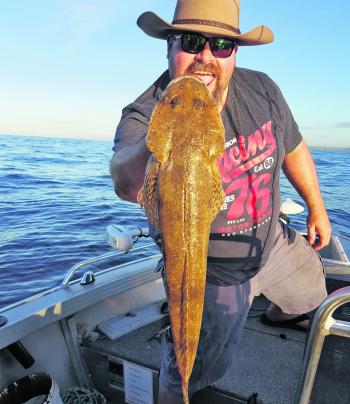
Tassie’s North West Coast is firing with plenty of flatties.

Anglers after a gummy shark haven’t been disappointed.
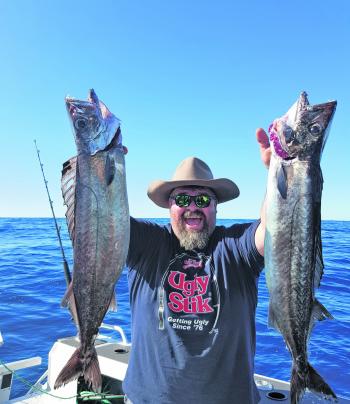
With chompers like these, you’ll want some tough tackle on your side.
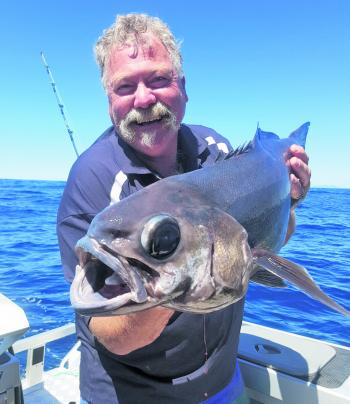
This trevalla looks like one intimidating slopper – any angler would be happy to best this beast.
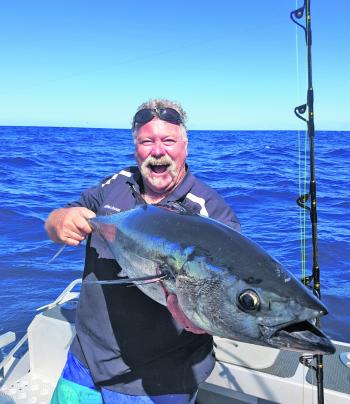
Tuna are hard fighters and it can take a team of tough anglers to pull ‘em up.
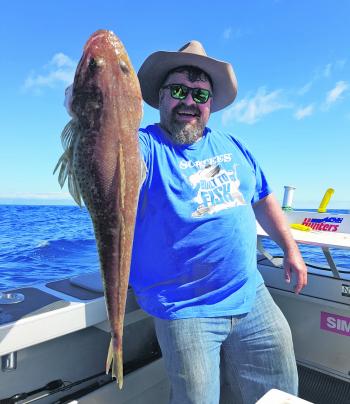
The flatties are huge around Tasmania and they’re on fire.

The scenery alone is reason enough to visit Flinders.
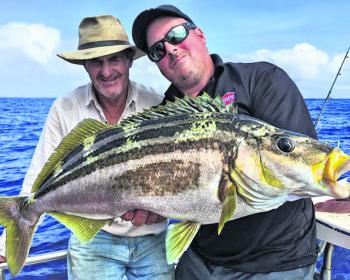
The deep sea fishing around Flinders is nothing short of exceptional.




